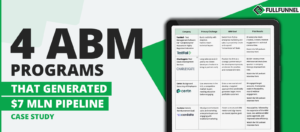In this guide, I share with you a step-by-step process that we use to develop a successful account-based demand generation model and ABM strategy.
This is the same process we use in all of our consulting projects, including:
- Pilot ABM campaign that generated $300k in revenue for an IT vendor
- Sales opportunities with 7 of 13 Tier 1 enterprise accounts for Google solutions vendor
- 70% reply rate for physical product digitalization platform selling to major European manufacturers
One caveat: you won’t find a theory here about what ABM is and how it is different from traditional marketing. There are dozens of guides written by ABM vendors, including Terminus and Hubspot.
I assume that you already know what ABM is and want to share the exact process you can use to develop an efficient account-based marketing strategy.
Let’s dive in.
Table of Contents
ToggleABM-fit and readiness checklist
Too many B2B companies get excited about account-based marketing and jump right into execution without evaluating if ABM is the right motion for them.
Before diving into ABM strategy development, I highly recommend going through the ABM-fit checklist and evaluating your readiness to launch ABM.
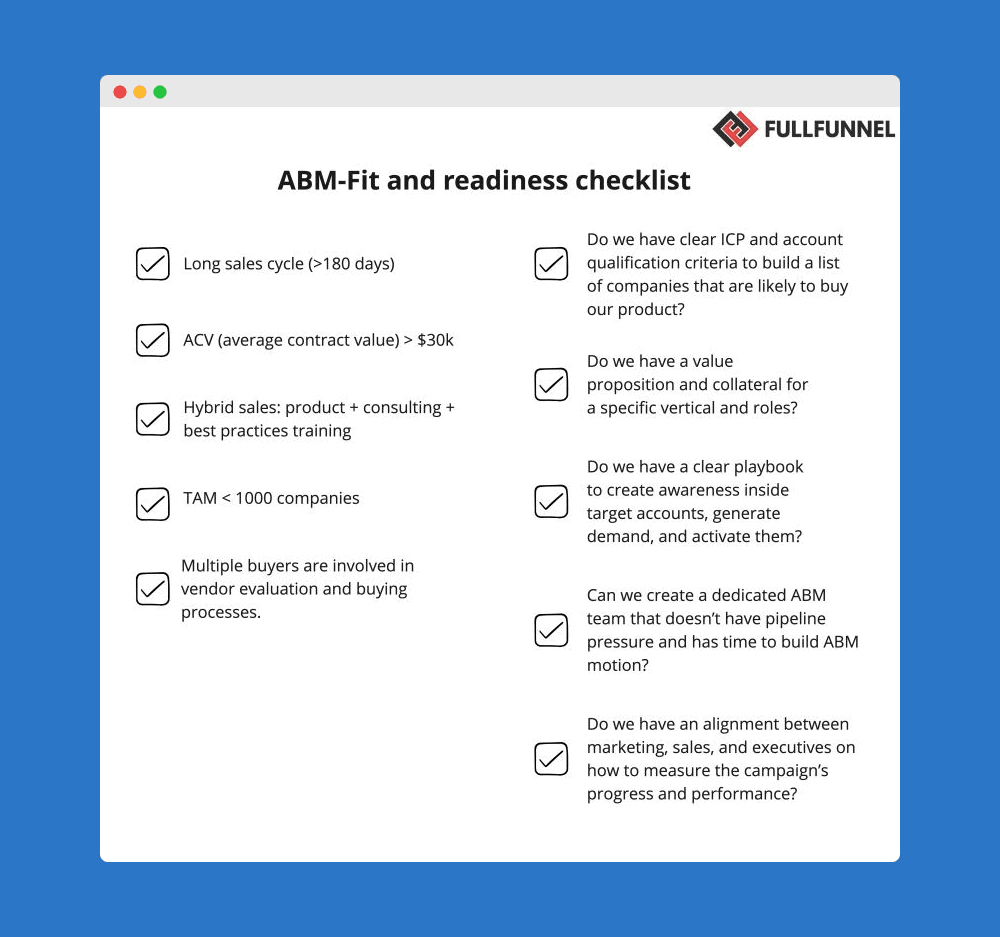
Let’s first evaluate if ABM is a right fit for your company by looking at 5 parameters.
1. Long sales cycle (>180 days)
If your sales cycle is short and transactional, I recommend focusing on demand capturing activities (ads, SEO, cold outreach) instead of ABM.
2. ACV (average contract value) > $30k.
Will it pay off to proactively market and prospect a specific set of accounts? I suggest considering ABM if the LTV or ACV of your best customers is higher than $30k.
3. Hybrid sales: product + consulting + best practices training.
ABM is extremely important when you don’t only sell products, but also sell your expertise in solving challenges your buyers have.
It includes product training, consulting alongside implementation, and training on best practices.
4. TAM (target addressable market) <1000 companies.
If your market is limited to 500–1000 companies across the globe, you have no other choices than ABM.
5. Multiple buyers are involved in vendor evaluation and buying processes.
If you usually deal with multiple people (3+) who influence the buying decision, ABM is a perfect strategy.
I weigh and prioritize the first three points. Here is why.
Your market can be more than 1k companies, or you might sell to an SMB where you don’t have lots of decision-makers, but ACV is high.
E.g. Software development service or enrichment software like Zoominfo.
If ABM is a right fit, next check your readiness to launch it.
5 questions to check your readiness to launch Account-Based Marketing
Here are 5 questions that will help to see if your company is ready to launch ABM.
1. Do we have clear ICP (Ideal customer profile) and account qualification criteria to build a list of companies that are likely to buy our product?
Start with selecting a target vertical and then develop ICP including 5 pillars:
- Firmographics
- Buying committee structure (roles, stages they join, reasons to buy and not to buy, KPIs)
- Account qualification and disqualification criteria
- Account segmentation
- Account enrichment (buying and demand triggers, research, evaluation, and decision-making processes, channels, etc.)
Many B2B companies make two critical mistakes when developing ICP for ABM programs.
a) Develop ICP based on a wish list of big logos.
I totally get that you want to have Microsoft’s logo on your website. But if Microsoft doesn’t have a need for your product, ABM won’t help.
ABM is not about magically converting any company into a customer. ABM is identifying companies that have a need your product solves and marketing to them with personalized solutions.
b) Going too broad with the ICP definition.
«All startups from Boston that have raised money recently», «Round A SaaS companies», «European financial institutions» are not ICP.
The broad targeting turns your company into a generic, one-size-fits-all vendor. Your buyers don’t see a difference from the competition and might buy only in case you provide a lower price.
You must accept the fact that not everybody is going to buy your product. The narrower your focus, the higher ROI you’ll see.
2. Do we have a value proposition and collateral for specific vertical and job roles?
Enterprise buyers don’t care about your elevator pitch. They care about how your product solves their challenges or helps to hit their OKRs. Hence, your value proposition should be tailored to specific vertical and individual buyers.
Keep in mind that there is always a risk of bringing an unknown/not well-known vendor. You need to create a buyer enablement program for a selected vertical to mitigate these risks, including
- Vertical implementation case studies
- Testimonials
- ROI justification
- Migration process
- Security, etc.
3. Do we have a clear playbook to create awareness inside target accounts, generate demand, and activate them?
ABM requires manual account development, including
- connections with multiple buying committee members
- engaging and building relationships with them
- identifying their needs and educating them on different ways to solve their challenges
- coming up with personalized solutions.
4. Can we create a dedicated ABM team that doesn’t have pipeline pressure and has time to build ABM motion?
As you can see from the ABM-fit checklist, launching the ABM program will take time. You need a dedicated team that can commit at least 70% of their time to run the program for the next 3–6 months.
Otherwise, in 2–6 weeks you’ll hear that “it doesn’t work”, and the program will be shut down.
5. Do we have an alignment between marketing, sales, and executives on how to measure the campaign’s progress and performance?
Define leading and lagging indicators to measure campaign progress and get approval from execs and sales.
I’ve shared all the points not to stop you from launching ABM. I wanted to explain that ABM is not an air cover and lead gen on steroids that can convert a wish list of accounts into your customers.
ABM is a strategic motion to identify companies that need your product, personalize your solution to them, and generate long-term customers.
To develop this motion, your company should allocate the resources and build a foundation.
There are no shortcuts.
If ABM is a right fit for your company, get step-by-step guidelines on developing an ABM strategy from scratch in our ABM playbook.
Why do many B2B companies fail in ABM or MarTech fairy tales
Most B2B companies I know have heard about ABM from ABM vendors (sounds logical, huh? ?).
There is one small issue here.
When ABM vendors talk about account-based marketing or share ABM playbooks, they are biased and create a wrong understanding of ABM.
Their playbooks heavily promote the importance of their software and set up a false expectation that typical ABM setup is:
- Create a wishlist of accounts and upload it to LinkedIn or ABM platforms (DemandBase, 6sense, etc.)
- Run IP-based display ads promoting landing pages, webinars, or gated PDFs.
- Track clicks, sign-ups, or downloads and send these «leads» to sales.
- Marketing: Follow up with direct mail swags that contain branded t-shirts/mugs & a box of sweeties
- Sales: add decision-makers from these accounts to the multichannel outreach sequence.
Why is this ABM setup doomed?
Here are 4 reasons.
- The B2B buyer journey is not linear. Clicks and downloads ≠ buying intent.
- Reach is miserable. B2B buyers spend most of their time outside platforms LinkedIn or ABM platforms can cover (Salesforce, Teams, Sharepoint, etc.)
- Lack of demand. Demand can’t be created via display ads only.
- Lack of personalization. Enterprise accounts ignore non-personalized messages from vendors they have never heard about.
Forget about the 1-to-many silver bullet fairy tale.
Just because it’s called ABM, it doesn’t mean you can create a wish list of Fortune 500 companies and convert them into customers.
ABM stands for marketing individually to specific accounts that have a need for your product and clearly articulating how your product might help.
To create a successful ABM strategy, you need to nail down 8 pillars.
- Goal setting
- Ideal customer profile
- Account list building
- Account research and value proposition mapping
- Account development (warm-up and activation) playbook
- Team and skillset
- Stack
- Reporting and tracking
I’ll review each of the pillars in the next section.
How to build an ABM strategy: 8 pillars
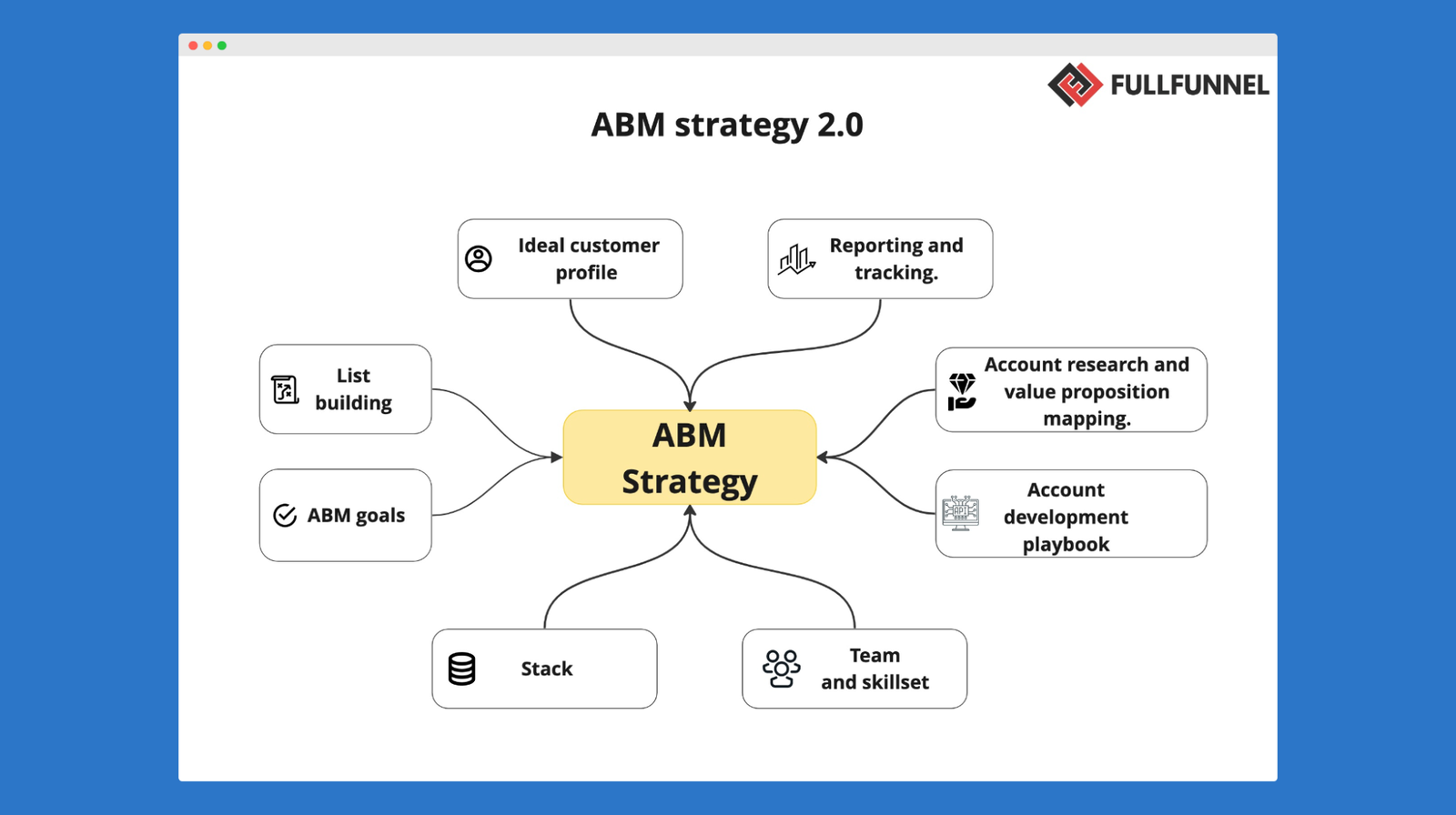
1. ABM goals.
Traditionally, B2B companies consider ABM campaigns only for net new revenue and leave money on the table.
There are 4 goals ABM helps to achieve (net new revenue is just one of them).
- Net new revenue – generate sales opportunities
- Pipeline acceleration – win stalled opportunities
- Expansion – upselling or cross-selling to existing customers
- Renewal / Churn prevention – renewing contracts with key customers
The most interesting fact is that 3 other campaigns aside from net new revenue are way easier to launch. But most B2B companies never do it.
Ideally, your ABM strategy should involve all 4 campaigns.
I’ll share the examples and playbooks of these campaigns later in this guide.
2. Ideal customer profile.
We published a detailed guide on developing an ideal customer profile for a B2B company, so I’ll share only the most important pillars of it.
Here are 5 pillars of ICP you need to work on.
1. Firmographics.
Here is what you’d do:
- Select the top 10 accounts by revenue from a specific segment.
- Define firmographic criteria that are important for you (stack, revenue, location, team size, etc.) and enrich each of the 10 accounts.
- Combine the firmographic data.
If you don’t know how to select a target market segment, read our GTM strategy guide.
2. Buying committee.
You don’t sell to companies, you sell to specific people. Here is a typical buying committee structure:
a) Champions.
Champions are in charge of initial product or vendor research. They attend discovery calls with you, prepare comparison reports, and provide info with personal takeaways from calls to the decision-makers.
Our example: an ABM marketer who wants to collaborate with us but needs approval from CMO.
b) Decision-makers.
Decision-makers are the key stakeholders who approve the budget or sign the contract.
c) Influencers.
Influencers don’t participate in product research or negotiations with vendors. But their opinion often matters during in-house vendor evaluation. They provide critical feedback or share their opinion about a specific offer.
Our example: CRO or head of sales who needs to delegate 1 SDR to the ABM team.
d) Blockers.
Blockers are the buying committee members who are not interested in your solution or might see a danger to themselves.
Our example.
Sometimes, external marketing agencies that work with our prospects might be blockers. They are threatened that our team can replace them (which is not true, btw ? ).
We are not a marketing agency and don’t initiate shifts in the organizational structure or a relationship with clients’ vendors.
Analyze selected 10 accounts and define a typical buying committee structure.
Again, we share a detailed breakdown of how to define a buying committee in the ICP guide.
3. Account qualification.
It’s not enough to have firmographic criteria only for account list building. You need to add custom criteria to qualify accounts.
Start with two questions:
a) What makes an account a good fit?
Examples:
- ACV (average contract value) is above $50k
- Actively hiring data analysts or engineers
- Have a specific keyword in their title or About section on LinkedIn (e.g. mobile SDK)
b) What makes the account a bad fit even if it fits firmographic criteria?
Look at the lost deals that fit your ICP. What do they have in common?
Examples:
- CFO is in the 1st year in a current position
- Massive layoffs in the past 6 months
- No funding in the past 12–24 months
You don’t need more accounts for your ABM program. You need fewer accounts that are likely to buy your product.
4. Account segmentation.
If a specific account can generate 20x more revenue than the average customer, why should you market to them the same way?
Shouldn’t you invest more in the research of this account’s needs and goals to make a highly personalized offer?
Shouldn’t you invest more in relationships and acquisition?
While everybody agrees, I see most B2B companies doing exactly the opposite. They define acceptable CAC (cost of acquisition) and target the entire market with the same marketing and sales message.
But if you want to land sales opportunities with enterprise accounts, forget about mass marketing. This is where account segmentation helps.
In ABM, we define three tiers inside your ICP for appropriate account segmentation.
Tier 1
Clients with the highest ACV or LTV. We run highly personalized, 1:1 campaigns to Tier 1 accounts.
Look back at the revenue generated in a specific segment and select customers that generate >10-15% of your revenue in that segment. Define the revenue potential Tier 1 customers have.
Tier 2.
To Tier 2, we add clients with medium ACV or LTV (e.g. those that generate 4-10% of your revenue). For Tier 2, we develop vertical and job role personalized campaigns.
Again, define firmographics and revenue potential.
Tier 3.
Tier 3 includes clients with the lowest revenue.
I believe that sales opportunities with Tier 3 accounts should come from your demand generation and demand capturing activities. You don’t need to run manual campaigns with sales to land deals with them.
Here is an example of account segmentation.

Get step-by-step guidelines on developing an ABM strategy from scratch and launching a pilot campaign in 6 weeks, in our ABM playbook.
5. Account enrichment.
To plan ABM campaigns, you need to understand how your Tier 1 and Tier 2 accounts buy. I recommend analyzing 5-7 recently won deals together with sales.
Pay attention to these 5 pillars.
1. Buying triggers.
What pushed your target accounts to start looking for your product? Try to understand the root reasons for the challenge.
Our example.
The company was growing because of the founders’ network and referrals, but last year the growth stagnated. They tried direct ads and outbound but didn’t generate any pipeline. They started looking for marketing advice and content about selling high ACV IT services.
2. Research process.
Where and how did they search? What information were they looking for?
Our example.
The CEO of the company I’ve mentioned above asked his network, and one of his peers recommended following me on LinkedIn. He saw some of the content and reached out. In parallel, he reached out to several ABM agencies and ABM tech vendors.
He was looking for a vendor who can share a clear framework for developing ABM motion from scratch adjusted to his business.
3. Decision-making process.
Discuss with sales what influenced the decision of these clients to buy your product? Who was involved in the product approval process?
Check who has attended the calls, who was in CC, etc. Next, discuss what persuaded them to go with you.
Our example.
Our client told us that our detailed ABM case studies, examples of ABM campaigns, clear frameworks, and niche expertise had the biggest impact on his decision.
4. Value they got from your product.
Discuss the challenges your product solves for each of the accounts, who uses it regularly, and what value they get.
Try to be specific.
Our example.
We ask clients to share pipeline and revenue results they got from a collaboration with us. Here is an example.
5. Deal source and channel presence.
Start with analyzing the source of the deal and then analyze each of the buying committee members.
What social platforms do they use?
Do they publish content or engage with others?
Do they like the content of your industry thought leaders?
Ideally, you’ll enhance your analysis with in-depth customer interviews (check the guide here). Your customers will share way more and open the curtain of their research and buying process.
When you finish the analysis, you’ll have a clear picture of
- who you need to target,
- what channels should you use,
- how you can amplify your reach,
- what playbooks you’d select to warm up and activate target accounts.
3. Account list building.
I’ve analyzed ABM campaigns that we ran to generate over $5mln in revenue for our clients. I’ve audited dozens of ABM campaigns that underperformed.
There is one thing that distinguishes great campaigns from losing ones. This is what accounts you are going to add to the ABM campaign and how you select them.
Let’s start with ABM campaigns that underperform.
- Here is how B2B marketers build an account list:
- They get a wish list from sales (e.g. we want to sell to Apple)
- They get a list of lost deals from sales.
- They build their own list based on broad firmographic criteria (e.g. SaaS companies from North America, 100+ people).
This setup is doomed.
Here are several reasons why.
- Lost deals were lost because of objective reasons. ABM is not a magic wand that helps to resuscitate them.
- Selling to enterprise companies requires a thorough playbook and multiple involved from marketing and sales. Selling to Apple could be a campaign itself.
- Broad targeting gives you a list of companies that are not aware of your product and might not have an existing need. Most of them will ignore your message.
Here are 4 sources that will help you select accounts that are likely to buy for a pilot campaign.
1. Intent data.
Install Leadfeeder or Clearbit to identify companies that actively engage with your key website pages:
- Pricing
- Case studies
- Comparison reports
- Book a demo, etc.
Define an engagement threshold and extract the accounts that hit it.
Here is how we do it at Fullfunnel.io
2. Demand gen programs.
Analyze your demand gen activities: webinars, events, newsletter, thought leadership, podcast.
Are there any companies that actively engage with your content?
Are there companies where you have more than 3 people engaging with you?
Are there companies that engage with several demand gen campaigns?
They could be great candidates for the ABM campaign.
3. Senior executives’ and sales’ personal network.
In case your company doesn’t run a demand gen program, and there is not that much relevant traffic, this step could be a great solution.
Analyze connections of your senior executives that fit your ICP, and ask sales to do the same.
Next, ask how close is the relationship.
There will definitely be several companies they have a strong connection with. Start a pilot campaign with them.
4. Associations and communities.
The last source works extremely well for companies operating in targeting conservative markets.
One of our clients sells to enterprise companies in the HVAC sector. We’ve partnered with an HVAC association in that region to run a market research and exclusive event for their members.
The HVAC association helped with promotion and intros to target accounts, we did the rest.
These 4 sources generate a list of companies that are already aware of your product and are likely to respond to your ABM campaign..
Never take a wish list or list of lost deals from sales. Only in case if the deal was lost of a missing feature that your product currently has, it makes sense to re-engage these opportunities.
Never create a list of 1000s companies that fit firmographics but are not qualified and have no engagement with your company.
If you don’t run demand generation campaigns, start with an existing network of your senior execs and sales, and leverage industry associations & communities.
This might work only for a pilot program, but keep in mind:
Best accounts for ABM programs are sourced from demand gen campaigns.
Later in this guide, I’ll cover a cohesive account-based demand generation model.
[cboxarea id=”cbox-Xl24t1Q5y2p8mA4x”]
4. Account research and value proposition mapping.

To come up with personalized solutions for your target accounts, you need to implement the research cascade method.
Here are the key steps.
1. Account research.
Collect and analyze all publicly available information about target accounts’ key initiatives and strategy.
Here are the main sources:
- press releases
- interviews with chief executives
- roadmaps
- corporate reports
- earning calls
- social media updates
I also suggest including the reason why we’ve selected this account to avoid creating a wish list. Also, add evidence that this account might have a need for your product.
Here is how account research might look like.
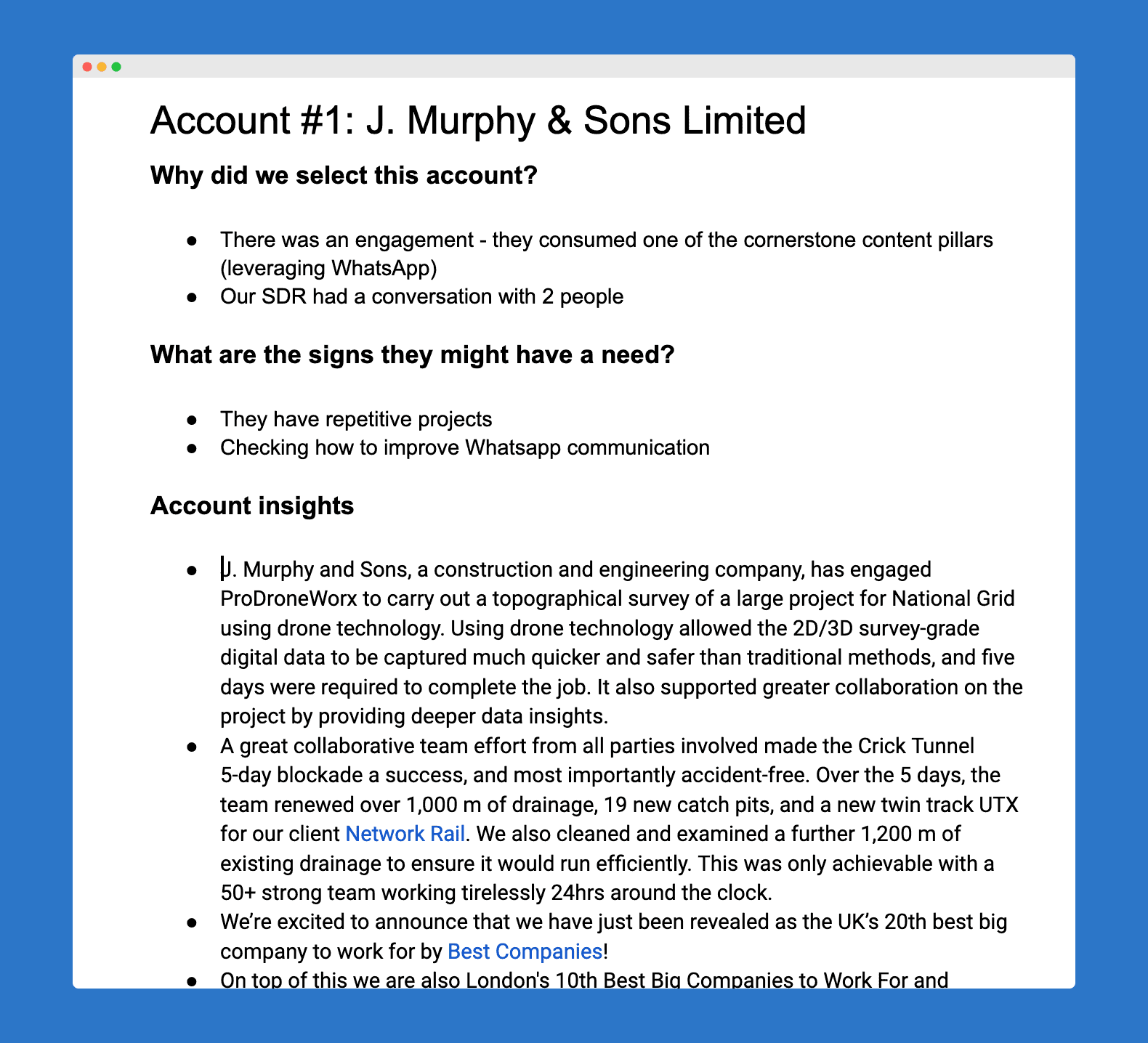
2. Buying committee research.
Research the buying committee and collect insights about how they might be involved in the key initiatives.
Here are several things you need to pay attention to:
- What’s their role and area of responsibility in the stated key initiative or strategy?
- KPIs/OKRs
- Challenges
- Goals
3. Value proposition mapping.
Start mapping your value proposition with the identified KPIs, goals, and challenges of every buying committee member.
Here is an example of a value proposition mapping for the company I’ve mentioned above.
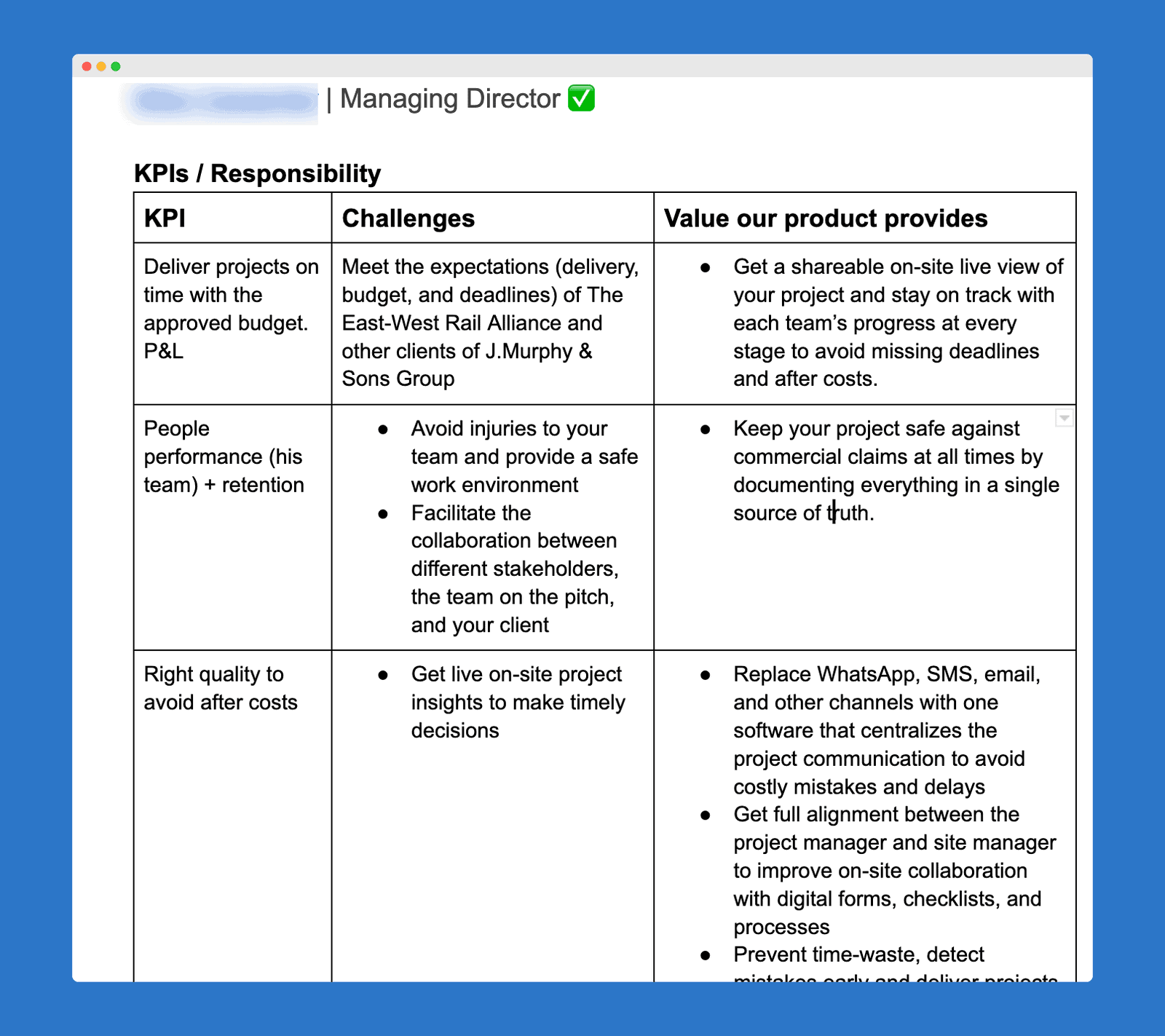
4. Personalized solutions.
Write down short (I recommend one-page docs) personalized solutions for every buying committee member.
Include:
- Context
- How exactly your product helps to achieve their goals or solve the challenges
- Relevant social proof
Here is an example.
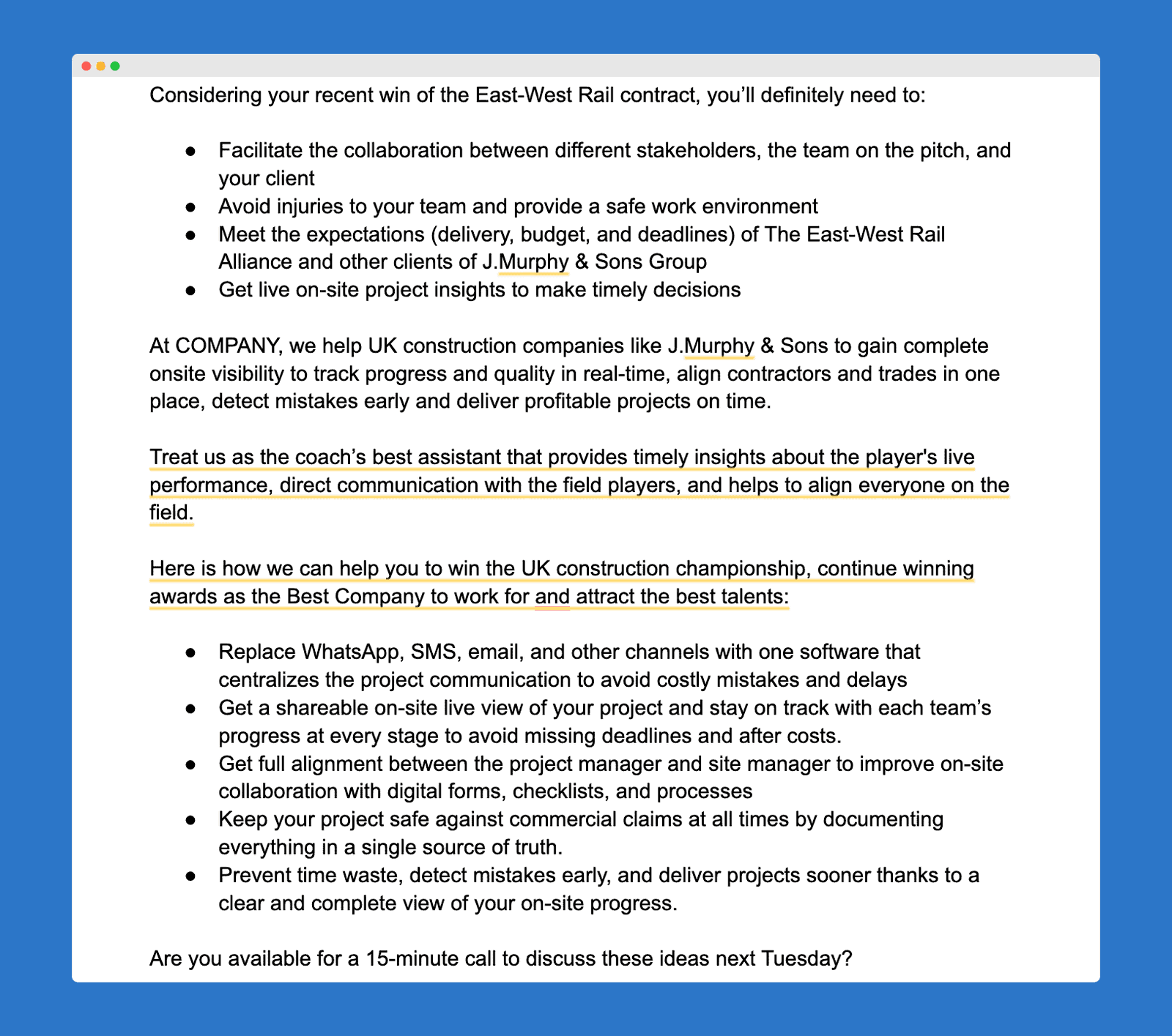 Tune in to the chat I had with Jim Gilkey from Terminus where we nail down each of the steps in detail.
Tune in to the chat I had with Jim Gilkey from Terminus where we nail down each of the steps in detail.
5. Account development (warm-up and activation) playbook.
Your next step will be the distribution of these personalized solutions to target accounts, which is basically the goal of account-based marketing. Create a multichannel warm-up and activation program together with sales.
Quite often I receive a question:
What is account warm-up?
Account warm-up is a playbook that includes specific tactics you are going to use to create awareness inside the buying committee of a specific account.
These activities might include:
- Social engagement and selling
- Personalized ads
- Content hubs
- Content collaboration
- Direct mail swags
- Micro-events, etc.
Most B2B companies that build an ABM motion make the mistake here. They assume that they can warm up target accounts with display ads.
Display ads could be a part of the warm-up playbook, but they can’t be the only tactic you run. Here is why.
1. Banner blindness.
How often do you click the banners you see?
If you think that your buyers are different, no, they aren’t.
2. Platforms outside your reach.
Your buyers spend most of their time on platforms that you can’t reach: CRM, Slack/Teams, Asana, Google Docs, etc.
So, how to warm up target accounts?
Here are my favorite playbooks.
4 warm-up ABM plays to create awareness in target accounts.
1. Content collaboration.
Ask yourself:
If a client is not going to accept a content engagement pitch, how can you expect them to reply to your cold outreach?
The best way to engage target accounts is:
- Asking them for a quote for the upcoming article
- Interview for your podcast
- Featuring them in the industry report. Here is a case study about the warm-up program that had a 70% reply rate.
You’ll be able to connect and learn more about target accounts and get unique insights for your content.
Fullfunnel.io examples:
- Marketing Positioning guide with 11 positioning strategies where we feature some of our clients and prospects.
- 146 B2B Execs Share: 8 Marketing Mistakes That Rob You of Revenue
2. Virtual events.
Create a diversified event strategy:
a. Top of the funnel, a vertical-based or solution-based event to create awareness of a target market.
We used this warm-up tactic with one of the clients that sell hardware to smart home installers to generate 34 sales opportunities and 5 clients. Here is a detailed case study.
Fullfunnel.io examples:
- Full-Funnel Summit
- 0 to ABM webinar (you can watch it below)
b. 1-few webinars to solve a common challenge of specific accounts.
Fullfunnel.io example:
Webinar about how to scale a B2B tech company outside the domestic market without direct sales or offline events. This is a challenge we learned from some of our prospects during market research in 2021.
We categorized the challenges, identified the most common, and invited marketing & execs from the companies who shared this challenge.
The webinar was attended by 12 companies in total. 2 of them became our clients later.
3. Social engagement.
If you are not selling to Refine Labs or Gong (companies with a huge social engagement), the chances that your comments will be noticed are really high.
Start with meaningful comments, move the conversation to DM, and get acquainted.
There are 6 pillars you can leverage (we’ll use LinkedIn as an example).

1. Thought leadership.
- Generating demand for your product.
- Proving niche expertise.
- Position yourself as a trusted advisor.
- Nurturing target accounts.
2. Thoughtful commenting.
- Create awareness & attract attention.
- Show your expertise.
- Repurpose comments into posts.
3. Engaging with a network of target accounts.
- Regularly appear in the newsfeed of the target accounts.
- Build a strong brand & a real relationship with the target audience.
- Generate and capture the demand.
- Educate & nurture the target market
4. Personalized connection requests.
- Higher reply rate
- Opportunity to build a real relationship
5. Non-sales touches.
- Stay on top of their mind & nurture the audience.
- Capture demand.
6. Engagement-based outreach.
- Higher response rate.
- Opportunity to get customer insights and see if there is a fit.
- Build a relationship.
- Capture the demand and generate a sales opportunity.
We cover this playbook in detail in our ABM on LinkedIn playbook. Check it here.
4. Demand generation ads and retargeting.
Demand gen ads and retargeting can enhance and accelerate your ABM program. But, again, they should be used in a mix with other tactics.
Most B2B companies make a huge mistake here. They either focus on demand capturing from cold accounts or promote gated content.
As a result, they deal with extremely high CPC and CPL and have a miserable «leads to opportunity» conversion.
Here is the truth.
In most B2B markets, there is no demand for your product. People simply don’t understand they have a problem your product solves.
You can’t create demand with direct conversion ads and cold outreach ONLY.
Banner blindness is real. CPC is drastically increasing.
But you can create demand when consistently talking about:
- the challenges your target buyers have,
- solutions & ideas they can apply,
- practical advice and market insights
Here are some ideas you can use for leveraging ads as a part of your warm-up program.
- Repurpose your best-performing organic content and promote it to your target accounts that engaged either with your content, visited your website, or signed up recently for the event.
- Use short clips from podcast episodes with the thought leaders and show them to their followers that fit your ICP. Later, retarget them with the content from step 1.
- Retarget accounts that visited your product page with case studies and short customer testimonials.
- Collect engagement insights, manually connect and engage with accounts that hit our engagement threshold.
Tune in to the chat with Justin Rowe where we share a step-by-step process of implementing this warm-up play.
5. Direct mail outreach.
We have a 100% reply rate for every direct mail outreach campaign we send at Fullfunnel.io. Our clients see positive reply rates of around 40%-60% per campaign.
Here is why.
- Direct mail cuts through the noise of spammy sales LinkedIn and email messages
- Relevant gifts grab attention and provoke curiosity
- Highly-personalized solutions and the relevant case study make target accounts reply YES just because it’s not standard, and they see we did homework.
One of the most common objections I hear from sales and executives is that this approach is not scalable.
It takes a lot of time to do the account research, buy the gifts, personalize the pitch, and wrap up the parcel. At the same time, everybody agrees that a highly personalized solution and creative outreach outperform the best-automated follow-up cadence.
Here is a detailed case study about the ABM campaign that generated $300k in revenue where I used direct mail as a warm-up tactic.
Watch a webinar below where I share several examples of our direct mail swags.
Keep in mind:
If you want to squeeze maximum ROI out of warm-up campaigns, mix these 5 tactics for maximum engagement.
Get step-by-step guidelines on developing an ABM strategy from scratch and launching a pilot campaign in 6 weeks, in our ABM playbook.
6. Team and skillset.
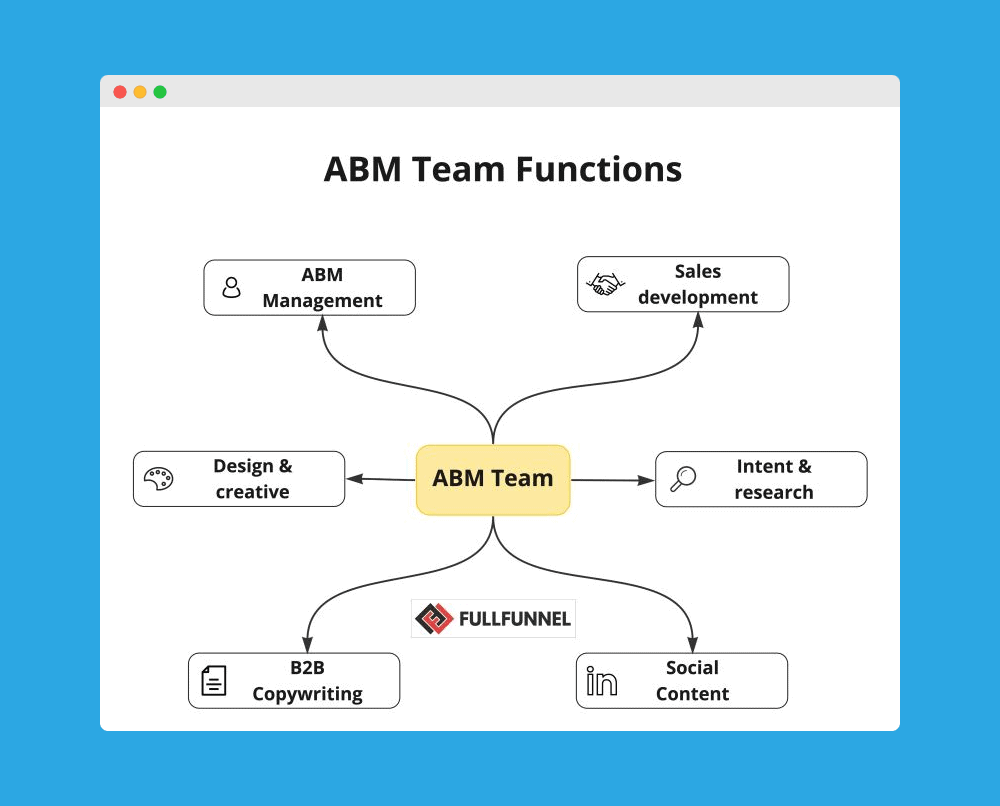
Here are 5 core functions you need to have in your ABM team. I deliberately wrote “functions”, not “people”.
For a pilot campaign, your marketer can replace the copywriter and split account research with SDR. These 2 people (1 marketer and 1 SDR) will be enough to launch a pilot. When you’ll be scaling ABM, you can hire people and grow your ABM team.
Anyhow, let’s come back to the 5 core functions to run ABM campaigns.
1. Senior ABM manager.
To orchestrate and run ABM campaigns you need somebody who has experience in marketing & selling to Enterprises.
Responsibilities:
- Campaign planning & orchestration
- Playbook for marketing and sales
- Setting up ABM stack and intent data sources
- Aligning ABM programs with demand gen, sales, and GTM strategy
- Setting up campaign dashboard and defining leading indicators
- Defining ICP, account qualification, and segmentation criteria
- Define engagement threshold and engagement triggers
- Budgeting programs
- Creating warm-up playbooks
2. Researcher.
The researcher is in charge of tracking different intent data sources, qualifying and segmenting accounts, and running account research.
For a pilot campaign, your marketer can be in charge of the account research. But when you’ll be scaling, you need a standalone unit to maintain the process.
Responsibilities:
- Managing, capturing, and qualifying intent data
- Transferring to the CRM engaged accounts
- Enriching the buying committee
- Running account research and saving insights for SDRs
3. Content marketer.
The content marketer will play a crucial role in the ABM campaigns.
Responsibilities:
- Personalized solutions
- Sales enablement content including case studies, team benefits, comparison reports, etc.
- Landing page copy (vertical or buyer level)
- Thought leadership content for SDRs who are not willing to create content
- Content for demand generation ads
For a pilot campaign, you can bring a content marketer from your demand gen team.
Otherwise, leave some of the functions to your marketer:
- creation of personalized solutions
- necessary sales enablement content
- thought leadership content that the marketer publishes from his own profile
4. Designer.
The designer can help with creating great visuals for thought leadership content and demand gen ads. As well, design the key assets:
- Landing pages
- Content hubs
- Personalized solutions
Here is an example of a personalized solution.
5. SDR.
While marketing focuses on awareness, demand generation and capturing, and warming up target accounts, sales should focus on activation.
The role of SDR in the ABM team is:
- Connect and engage with the entire buying committee of engaged accounts
- Checking account research insights and coming up with personalized pitch ideas
- Leverage thought leadership and non-sales touches to consistently nurture target accounts
- Getting insider insights from peers and network
- Reach out and follow up during activation phases
- Sharing marketing insights from convos with target accounts
- Working together with Senior ABM marketer on ICP, account qualification and intent data sources
I’ve described an ideal skillset you’d have in the ABM team despite the company’s size. The ABM team may vary depending on where you are in your ABM journey.
If you start out and run a pilot campaign, start with 1 marketer and 1 SDR. When you’ll be scaling ABM, make sure you have all the 5 units I’ve mentioned above.
7. ABM stack.
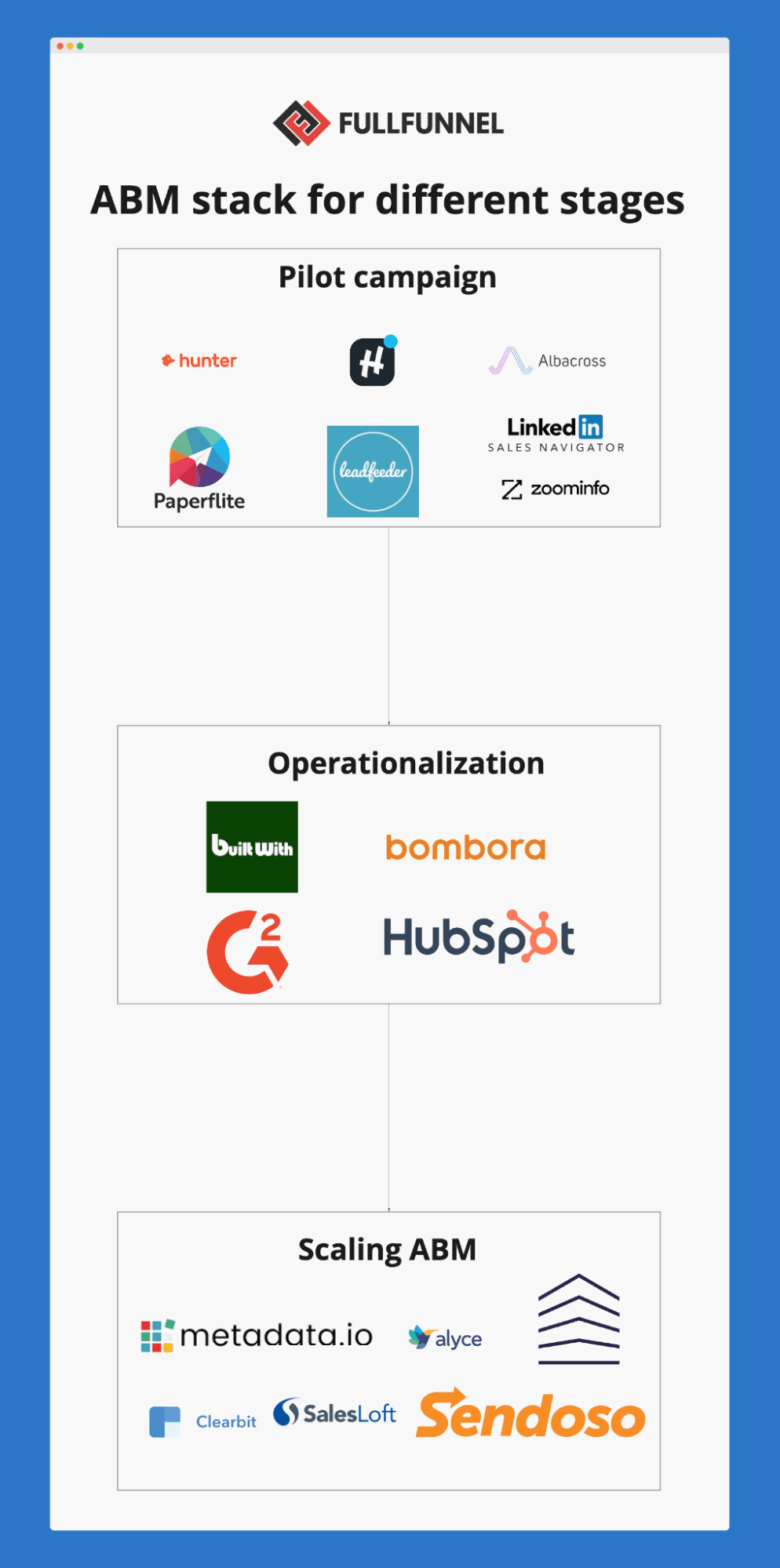
Your ABM stack will depend on how mature is your account-based marketing motion. When you build an ABM strategy, don’t be obsessed with purchasing ABM software. On the contrary, try to stick to the existing stack or add only essential software.
Later, when you’ll be scaling ABM motion, you can add more software that helps to enhance your processes.
Here is a stack for different ABM maturity stages.
1. Pilot stage.
Keep your stack lean and don’t overinvest in tech. You don’t have processes and don’t know what areas of the ABM campaign could be refined.
Lean stack for a pilot ABM campaign:
- Intent data. I suggest starting with website visitor identification software: Happierleads, Leadfeeder, or Albacross
- Account list building: LinkedIn Sales Navigator
- Account enrichment – Lusha or Hunter.io
Content hubs: Paperflite
2. ABM Operations.
While you document the processes and create marketing and sales playbooks, start building your stack.
You can add:
- New sources of intent data depending on your needs (G2, Bombora, BuiltWith, Mention, etc.)
- Marketing automation for email nurturing & retargeting (Hubspot)
3. Scaling ABM.
When you’ve vetted playbooks and made ABM an evergreen process, you can start scaling ABM.
At the scaling stage, you can add to your stack more advanced marketing automation and account enrichment software.
You can add to your stack:
- Account enrichment and profiling solutions (Cognism, Clearbit)
- Programmatic multichannel ads (metadata.io)
- Gifts delivery (Sendoso)
- Sales cadences for Tier 3 accounts (lemlist, Salesloft)
Before you’ll invest in more expensive ABM software, make sure you have robust playbooks and generate opportunities with a lean stack.
Don’t build a stack and don’t invest in expensive software before creating ABM processes and onboarding marketing, and sales teams.
The software can refine and accelerate the processes but not replace them.
Strategy -> Resources -> Pilot campaign -> Process -> Stack.
8. Reporting and tracking.
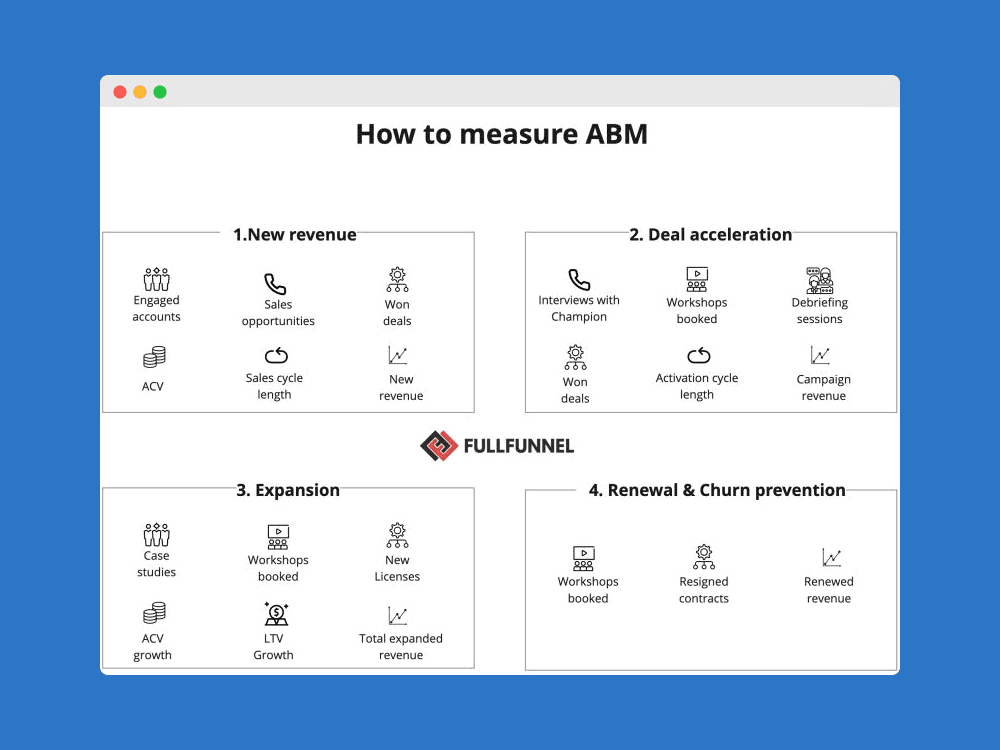
In the beginning, I’ve mentioned that there are 4 typical goals you can achieve with ABM campaigns:
- New revenue
- Deal acceleration
- Expansion
- Renewal / Churn prevention
These campaigns have different playbooks, hence, the reporting is different.
Here is how to measure each of the 4 campaigns.
1. Net new revenue.
Campaign goal: new opportunities and revenue.
Core metrics:
- # of engaged accounts (replied, no immediate need, but are interested in learning more)
- # of discovery calls booked
- # of sales opportunities
- ACV
- Sales cycle length
- Won deals
- New revenue
- Budget
- ROI
Here is an example of an ABM report.

2. Deal acceleration.
Goal: Winning existing opportunities.
Example campaign playbook:
- Define appropriate warm-up play and how to engage the buying committee
- Debrief Champion about blocking points in the buying process
- Prepare a personalized content hub with a doc that addresses the blocking points, content that demonstrates the benefits for different buying committee members + case studies
- Suggest a quick workshop to move the buying committee through your framework
- Suggest 1-1 debriefing sessions with peers (e.g. IT dep with your CTO)
Standard metrics (they may vary depending on a campaign playbook):
- # of interviews with Champion
- # of workshops booked
- # of debriefing sessions
- Won deals
- ACV
- Activation cycle (from interview to the invoice. You can compare it later with the sales cycle length).
- Campaign revenue
3. Expansion.
Goal: Expand business with existing clients.
Example playbook:
- Create a case study and interview power users, Decision-Makers (DMs), and Champions about the value and results they are getting from your product.
- Find common connections in other departments and/or branches and ask Champion to make an intro when possible.
- Run a campaign with excerpts from the interview and the case study to warm up the buying committee.
- Ideally, co-host a webinar with the Champion inviting other departments/branches.
- Create a personalized content hub explaining the benefits of a new department or branch that they can get from your product.
- Suggest 1-1 debriefing sessions with peers
Metrics:
- # of case studies created
- # of workshops arranged
- # of new licenses sold
- LTV growth
- ACV growth
- Total expanded revenue
4. Contract renewal / Churn prevention.
Goal: renew contracts with key accounts.
Example playbook:
- Interview Champions, power users, and, ideally, decision-makers about new initiatives and goals.
- Create a presentation about product roadmap and updates, and tailor it to accounts’ goals (how they can benefit).
- Book calls to present the roadmap.
This campaign can be merged with an expansion campaign.
Metrics:
- # of presentations booked
- # of resigned contracts
- Renewed revenue
Get step-by-step guidelines on developing an ABM strategy from scratch and launching a pilot campaign in 6 weeks, in our ABM playbook.
ABM planning: 3 stages of ABM

In the previous section, I shared how to measure different ABM campaigns and shared examples of playbooks.
When you nailed down your ABM strategy, the next step is planning all 4 ABM campaigns.
Sit down with your sales team, look at sales pipeline velocity and discuss what campaigns should have the highest priority: expansion, acceleration, churn prevention, or net new revenue?
Don’t try to launch them all in parallel unless you have a robust ABM motion.
Here are 3 stages I recommend you follow.
1. Pilot campaign.
Follow the 1-1-1-1-1-1-1-10 framework.
This framework stands for:
- 1 market
- 1 vertical
- 1 SDR
- 1 marketer
- 1 source of intent data
- 1 warm-up tactic
- 1 tier
- 1 goal (expansion, net new revenue, acceleration, renewal)
- 10 accounts (3 buying committee members per account) max
Why?
The Pilot campaign is an experiment. You make hypotheses about your ICP, do preliminary account research, and learn a lot about target accounts.
You need to apply learnings to improve account qualification criteria, account research process, and activation processes.
The goal is to launch a campaign fast with minimum resources to avoid losing momentum and trust from execs and sales.
Don’t do:
- Including lots of accounts in the pilot program, you won’t be able to run ABM properly
- Adding a wish list of accounts instead of engaged accounts
- Allocating big budget
- Involving the entire sales team. You need 1 SDR who’ll be your Champion in the sales team helping to scale the program later.
2. ABM operations.
Do:
- Installing new sources of intent data to identify engaged accounts
- Documenting campaign
- Creating marketing and sales playbooks
- Creating ABM tech stack
- Turning pilot campaign into an evergreen process
- Launching a new pilot campaign with a new warm-up tactic
Don’t do:
- Adding more salespeople to the program
- Investing in expensive ABM software or adding ads as a warm-up tactic
Your goal is to embed ABM into your marketing operations and make it an evergreen process instead of one-time campaigns.
3. Scaling ABM.
Do:
- Creating a core ABM team
- Onboarding more SDRs and marketers with documented playbooks
- Including new verticals and markets
- Modifying campaigns for tier 2 and tier 3 accounts
- Embedding ABM into marketing operations and demand generation
Don’t try to skip these phases and launch mass campaigns right from the bat.
You won’t be able to execute ABM properly and lose money, trust, and support from sales & execs.
Learn more about going from 0 to ABM in this webinar:
Merging ABM with demand generation: a cohesive model

One of the most common mistakes I see B2B companies make is creating siloed demand generation and ABM functions. Don’t make a mistake by considering developing a demand generation function instead of ABM. Build a blended model instead. Here is how.
1. Look at the demand generation campaigns you’re currently running and define the engagement data you can leverage.
Examples.
- LinkedIn: awareness ads / thought leadership: likes/comments, following page, visiting product/pricing/use cases pages on the website
- Newsletter: sign-ups, open rates, click rates, inviting colleagues to sign up
- Webinars: sign-ups / repeat sign-ups, inviting colleagues to sign up
- Content hubs: time spent consuming key content (case studies, comparison reports, product overview), repeat visits
2. Define the engagement threshold.
Example:
- Account spent >30 minutes on the website checking product page, pricing, and case studies.
- At least one person from the buying committee is signed up for the newsletter and opened at least one of the last 4 broadcasts.
- At least one person from the buying committee signed up for the last of 3 webinars.3. Segment and qualify identified engaged accounts.
3. Qualify accounts.
Even if the account matches ICP criteria, are there any other factors that can tell us that this account is a bad fit?
Examples:
- SaaS with pricing of <$100 / month
- Decision-maker has a sales background
- <200 SKUs in the portfolio
4. Segment accounts
Tier 1 accounts (highest revenue potential): 1-1 highly personalized campaigns
Tier 2 accounts: vertical-based and job-role-based personalization.
Tier 3 accounts: vertical-based personalization. Retargeting and automated activation (e.g. LinkedIn conversational ads).
I believe that Tier 3 accounts should be generated via demand generation programs.
5. Account research & warm-up.
We collect all the publicly available insights about the strategic initiatives of the qualified accounts and map out the buying committee.
This is crucial before defining how to market to every specific company and what warm-up tactic to use.
6. Activation.
The last part is matching the insights we collected from account research and warm-up program, and creating completely personalized proposals for every buying committee member.
This is where you can leverage a creative outreach (we love to send direct mails).
If the deal is won, we move it to client success. When a client achieved the desired result, you can start an expansion campaign.
If the deal was lost or stalled, you’d continue nurturing the account with your demand gen program and non-sales touches.
Get step-by-step guidelines on developing an ABM strategy from scratch and launching a pilot campaign in 6 weeks, in our ABM playbook.
11 mistakes B2B companies make when developing an ABM strategy.
To end this massive guide, I want to share typical mistakes B2B companies make with ABM. Use this section as a checklist.
1. Focusing on net new revenue only.
The easiest way to get results fast is to accelerate the pipeline, expand the businesses or run a contract renewal campaign.
2. Creating a wish list of accounts with no intent to buy.
Everybody wants to have Apple’s logo on their website, but if Apple has 0 interest in your product, you’re going to waste your budget.
3. Skipping warm-up campaigns.
Uploading a list of accounts to LinkedIn or 6sense isn’t a warm-up campaign, it’s just one channel tactic.
You can warm up accounts only when you’ll have:
- meaningful engagement via social channels,
- co-marketing,
- content co-creation,
- micro-events
where you’ll have a chance to have 1–1 conversations.
4. Building account list without intent data.
Instead of building an account list based on firmographic data, identify accounts that are already “aware” of your product and engaged with your content. Your reply rate will be much higher than reaching out to a completely cold audience.
5. Developing a campaign without a clear activation playbook.
To succeed with ABM your sales team must know when they should do follow-ups, what they should say/write, and whom they should follow up with. Sending a templatized email follow-up is not an activation playbook.
6. Focusing on decision-makers only instead of the entire buying committee.
Everybody wants to have a meeting with decision-makers, but getting a call from C+ from 5000+ employees is almost impossible. Even, if you’ll get an intro, in most cases you’ll be transferred to other team members.
7. Skipping account research to personalize campaigns and pitches.
Nobody cares about your unique value proposition and how you can help the company. The buying committee members care about their own performance and KPI. Optimize your pitch accordingly.
8. Not setting disqualification criteria.
The fact that the account fits your firmographics criteria doesn’t mean it’s a good fit. The more disqualification “red flags” you’ll set up, the better your list will be.
9. Making decisions fast about what works and what doesn’t.
If your sales cycle is above 6 months, don’t get caught up by making fast decisions about what works and what doesn’t. To measure the success of your ABM campaigns (especially, new revenue campaigns) you need to set up leading indicators like:
- # of engaged accounts
- # of positive replies
- # of SQOs
- sales pipeline value
10. Buying an expensive tech stack instead of developing the ABM process.
Software can’t replace the process, it only helps to refine it. Develop ABM process first including:
- list building
- account enrichment & research
- warm-up
- activation
- follow-ups & nurturing
11. Launching a mass campaign from the bat.
The more accounts you’ll have in a pilot campaign, the harder it will be to launch the campaign properly and get the results.
Takeaways and next steps
The success of account-based marketing lies not in your stack or budget, but in solid foundations.
Make sure you have a team and skillset that can dedicate enough time to developing ABM strategy and maintaining the motion.
If you need help with developing an ABM strategy, book a call here or dm me on LinkedIn with additional questions.
If you want to uplift your skills and learn more about ABM strategy, get step-by-step guidelines on developing an ABM strategy from scratch and launching a pilot campaign in 6 weeks in our ABM playbook.
Inside you’ll find:
- 18 short, actionable training videos that explain how to launch a pilot ABM campaign on a minimal budget and land sales opportunities with dream accounts just in 6 weeks
- 4 actionable, orchestrated for you ABM campaigns
- Worksheets and dashboards you need to launch a pilot campaign including:
- Ideal customer profile template
- Account research template
- ABM campaign dashboard
- Pilot campaign slides
- Phone follow-ups template
- Account qualification template
- Campaign analysis template
- Lifetime access to the course and future updates
Learn more and access 6-weeks ABM playbook here.




